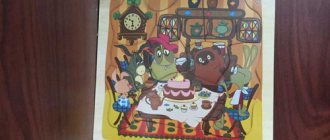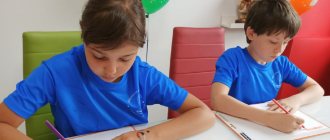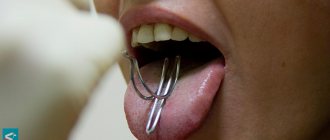Such a variety of etiological factors for speech impairment indicates the need for parents to take their children’s speech problems seriously, since in some cases they may indicate serious pathologies, including those of the brain. A timely visit to a qualified pediatric speech therapist will help identify the reasons for the lack of speech or its underdevelopment in the child, and prescribe adequate treatment and correction.
In the speech therapy departments for children of the NEARMEDIC network of multidisciplinary clinics, pediatric speech therapists of the first and highest qualification categories, who have scientific titles and many years of practical experience in correcting speech in the absence or underdevelopment of a child in the best domestic and foreign clinics, advise.
For young patients, the NEARMEDIC network of clinics provides the opportunity, if necessary, to consult with any specialists in the field of pediatrics - neurologists, psychologists, otolaryngologists, as well as undergo all the necessary instrumental and laboratory examinations in the network’s own multifunctional laboratories, equipped with the latest technology.
The most modern physiotherapeutic technologies influencing articulation equipment are available to children.
An integrated approach to the treatment of children in the absence of speech or its underdevelopment gives excellent results in such speech pathology as alalia, preventing the development of secondary intellectual disability in the child.
Speech disorders in children
All forms of speech-language pathology were initially described by physicians because initial descriptions involve clinical intervention. However, these are isolated studies (S.S. Mnukhin, E.I. Kirichenko, A.N. Kornev). Children with various complaints about speech disorders often first go to the doctor, who then refers them to a speech therapist. Accordingly, all research on speech disorders is in the field of speech therapy.
Unlike adults, children independently and spontaneously master language while being in a full-fledged language environment. This is hard and serious work that requires the use of a wide range of cognitive abilities:
- language and intellectual capabilities;
- planning skills;
- ability to concentrate and switch attention;
- states of articulatory praxis, etc.
All this is necessary to master the language. If cognitive abilities are limited and immature, then it will be difficult for a child to learn to speak independently without the help of a specialist.
Epidemiology
The sooner a problem is identified, the easier it is to cope with it - correctional work and medical and psychological assistance will be more effective. Today, in speech therapy, speech disorders are identified at the age of 5-6 years and later.
There are a lot of children with speech disorders in Russia:
| Russia | English-speaking countries | |
| 5-6 years | 25-30% | 4-5% |
| 7-8 years | 17-20% | 3% |
| Over 8 years old | 1% | 1% |
| Boys/girls | 3:1 | 2:1 |
The table shows the percentage of those children who have speech deficiencies that require specialist intervention. By about 6 years of age, children fully master language skills in terms of pronunciation and grammar. Before this, they are allowed to make certain mistakes, according to their age. However, it is important to understand that each age has its own acceptable and unacceptable speech errors.
If we compare with English-speaking countries, the difference is quite noticeable. This large gap is related to diagnostic criteria, not to the children's abilities. Nevertheless, the number of children with speech disorders is quite large. Most often boys suffer from the pathology.
Causes of dysontogenesis
The nature of the development of speech pathologies is traditional. Reasons include:
- Constitutional (hereditary) forms. It occurs most often; most speech disorders have a hereditary factor.
- Somatogenic forms. A child aged 1-2 years suffered some serious illness for his age. If the disease occurs during a sensitive period for speech, this may affect the full development of speech.
- Cerebral-organic forms. They develop as a result of pathologies during pregnancy or difficult childbirth.
- Deprivation forms. Emotional and communicative deprivation, which in most cases occurs among residents of orphanages and orphanages.
- Forms of mixed genesis. Combine two or more of the above forms.
Treatment, diagnosis
To understand the cause of RRR, you should undergo special diagnostics. The baby must be shown to a neurologist, psychiatrist and otolaryngologist to rule out medical pathologies. If no diseases are identified, they seek help from a speech therapist-defectologist or psychologist. Often several specialists have to deal with correction and therapy. Doctors do not advise looking for the cause of the lack of speech on your own or doing anything at home so as not to harm the child. ZRR at 5 years is a serious problem that should be dealt with by qualified people.
The table below will help you understand who to contact for a certain diagnosis.
| Pathology | Who is dealing with the problem |
| Aphonia, lack of hearing, hearing loss | ENT, speech therapist-defectologist, phoniatrist |
| Rhinolalia | Speech pathologist, surgeon |
| ZRR | Speech pathologist, neurologist, psychologist |
| GSD (general speech underdevelopment) | Neurologist, speech therapist-defectologist, ENT |
| Autism | Psychiatrist, psychologist, neurologist |
| Aphasia | Speech pathologist-defectologist, neurologist |
| Alalia | Speech pathologist-defectologist |
| Mental retardation | Oligophrenopedagogue, neurologist, psychologist |
Timely diagnosed pathology will allow complex treatment to begin as early as possible. With this approach, in most cases it is possible to achieve high-quality speech by the time of schooling. Therefore, if a preschooler has no or impaired speech, you should contact a speech therapist or neurologist, who will conduct a diagnosis and identify the cause of the pathology.
Partial PNR
PND stands for primary speech underdevelopment. Classification of partial PNR:
- Functional dyslalia. These are defects in individual sounds that can be easily eliminated (in a couple of weeks/months).
- Articulatory dyspraxia (dysphonetic, dysphonological and dynamic forms). It represents polymorphic pronunciation disorders that are associated with a violation of cerebral support, i.e. with inferiority at the neurobiological level. Dyspraxia may be accompanied by problems with vocabulary and grammar. Requires longer correction.
- Developmental dysarthria. The causes of dysarthria are pathologies during pregnancy and birth trauma.
- Rhinolalia. These are serious speech disorders that occur due to the incorrect structure of the dentofacial apparatus.
- Dysgrammatism. It manifests itself in selective violation of the rules of grammar, agreement of words by gender, number, cases, etc. Reflects exclusively the grammatical side.
This classification is notable for its clinical focus. That is, it can be used by both speech therapists and doctors.
In addition to partial speech disorders, secondary speech underdevelopment is also distinguished. They are associated with pathologies of physical and mental development (for example, hearing impairment, mental retardation, mental retardation, etc.).
Causes
The reason for the appearance of sensory alalia in a child is damage to certain areas of the brain that are located in the cortical part. These zones are responsible for the speech apparatus, understanding and analysis of audible sounds. The following factors can lead to such a violation:
- Diseases that arise in the first years of a child’s life.
- Central nervous system disorders that arose during complicated childbirth.
- Fetal pathologies that appeared during pregnancy.
A speech disorder such as sensory alalia can also be caused by other reasons. Diagnosis of the disease is possible only after a complete examination of the baby by specialists such as a neurologist, speech therapist and psychologist.
Total PNR
With total speech impairment (TSI), there are deficiencies in all areas of the language: phonology, sound pronunciation, grammar and vocabulary. The child's mastery of all language means is generally impaired.
The disorders presented in the classification are classified as severe:
1. Alalic variant (motor and sensory alalia). With motor alalia, a child under 4-7 years of age does not use speech, except for a set of babbling words (for example, woof-woof, co-co, bi-bi). The child cannot fully communicate, which entails serious impairments in communication capabilities. It is relatively rare - 0.5%.
Sensory alalia is an even more severe condition in which the child does not understand spoken speech and does not connect words with meaning. The disease has been little studied and is difficult to diagnose. Correction not started in time (from 2-3 years of age) can cause serious maladaptation and lead to disability.
2. Paraalalic version of THP. The symptoms and signs are similar to motor alalia, but it proceeds much easier and is overcome more quickly (in 2-3 years).
3. Clinical forms with a complex type of disorder (“mixed”).
If by the end of preschool age it is not possible to cope with dysontogenesis, the child is sent to study at a speech school. To achieve noticeable results, correction work must continue for at least 5-6 years. A regular school can only aggravate the child’s condition: serious difficulties will arise in learning, and a lack of oral speech causes deficiencies in written language.
Comorbidity
Total PND is characterized by a high comorbidity rate. 60-70% of children with sound pronunciation disorders have problems with attention, memory and the emotional sphere. 50% of children with dyslexia and 60-80% of children with mental retardation or mental retardation have oral speech disorders.
Speech impairment is quite often accompanied by many disorders:
1. Cognitive deficit:
- random access memory;
- verbal-logical functions (the ability to think categorically using generalizing concepts);
- successive operations;
- finger and articulatory praxis;
- attention (auditory, rarely visual);
- immaturity of gaming competence.
2. Personal sphere:
- surface of social connections;
- immaturity of the emotional-volitional sphere.
3. Communicative competence:
- poor command of dialogue (especially monologue);
- difficulties in establishing partnerships.
The lack of language means limits the possibility of mastering verbal and logical skills in thinking. This can affect the personal sphere, because difficulties arise in communicating with peers and adults. If the child received timely and comprehensive help, the outcome will be more favorable. Comprehensive care means both the participation of a speech therapist and the participation of doctors.
Dysontogenesis is dangerous with negative consequences. The child has difficulties in learning in basic subjects, there is an inferiority of socio-cultural discourse and behavioral disturbances. It is worth talking separately about dyslexia and dysgraphia, since these are the most serious disorders that follow speech impairment.
Symptoms
With a form of disorder such as sensory alalia, the child is unable to understand speech that was addressed to him. If the disorder is severe, then the child may experience absolute indifference to any sounds, regardless of the nature of their origin. The patient does not respond to his name and cannot distinguish the speech of an adult from any other sounds in space. If the form of the disorder is mild, then the child can demonstrate understanding of individual words from everyday life.
With sensory alalia, the child’s speech activity is quite high, but he utters only simple sounds, the meaning of which cannot be understood by others. The child is not able to repeat words after adults, and he also cannot compare objects and words.
A distinctive feature of this type of alalia is the repeated repetition of any sounds without understanding the meaning of what was said.
Dyslexia through the eyes of a doctor
Dyslexia as an independent disorder was first described at the end of the 19th century by English ophthalmologists. The pathology was defined as word blindness - the child is intellectually developed, but cannot recognize words. In Russia, such cases were first described by R.A. Tkachev and S.S. Mnukhin.
Dyslexia is a specific reading disorder. About 10% of children experience difficulties mastering reading during their school years. Compared to other children, they are not able to learn to read in the proper time. After finishing school, many of them remain semi-literate.
Dyslexia is a condition whose main manifestation is a persistent, selective inability to master the skill of reading, despite a sufficient level of intellectual and speech/language development, the absence of hearing and visual impairments, and optimal learning conditions.
Diagnostic criteria according to ICD-10 – F81.0. Specific reading disorder.
Signs of dyslexia:
- Reading technique and/or reading comprehension is below what is expected for given intellectual development. First, there is a slow development of syllabic reading, and then slow reading in words, which greatly complicates the understanding of texts. Both in the lower grades and in the older grades, the child automatically reads most of the words syllable by syllable.
- The disorder is not a direct consequence of a visual or hearing defect, or a neurotic disorder.
Symptoms of dyslexia vary by language. In the English language, dyslexia can be recognized by incorrect reading and a huge number of errors, in the Russian language - by extreme slowness and automation.
Epidemiology of dyslexia
This pathology has been poorly studied in Russia, while in English-speaking countries millions of books and articles have been written on the topic of dyslexia, and in the USA the problem was discussed at the Congress level. The results of a survey conducted by the Association of Parents of Dyslexics showed that the vast majority of parents and more than half of teachers in Russia do not have the slightest idea about dyslexia. In fact, dyslexic children are left to their own devices and do not receive the necessary help. There are a lot of such children:
- in the Russian population of school-age children 5-6%;
- L/m ratio: severe forms – 1:4.5, medium form. heavy – 1:1.5;
- among children with mental retardation – 50%
- among children with speech underdevelopment – 40-50%.
5-6% on a Russian scale is approximately 700-800 thousand children. After finishing school, they feel like foreigners in their native country, since they cannot work with texts. These are huge numbers and from this side dyslexia becomes a socially significant problem.
Dyslexia is characterized by sexual dimorphism in favor of boys. Dyslexic boys are many times more common than girls.
Cerebral mechanisms of dyslexia
Reading is a rather labor-intensive process that develops certain brain structures. Dyslexics have difficulty reading because their brains have serious developmental features - malformations or ectopia, when neurons are located in the wrong place where they are supposed to be. This study was conducted by Galaburda in 1985. Look at fig. 1 - everything that is indicated in red are numerous zones of ectopia.
Rice. 1.
The dyslexic brain shows signs of dysembryogenesis. MRI can identify typical, recurring abnormalities in certain areas of the brain. In Fig. 2 yellow-red color shows a decrease in gray matter density in dyslexics, and blue color shows an increase. These are also signs of dysontogenesis, which are most often found in the left temporal lobe of the posterior part of the middle temporal gyrus.
Rice. 2.
Functional MRI can identify key areas of the brain involved in text processing. Look at fig. 3 – while reading, a normally reading child activates 3 key zones, highlighted in red: superior temporal, frontal and inferior temporo-occipital. In dyslexics, only one zone is allocated, and the temporal and temporo-occipital areas are not involved in information processing - this is a sure sign that the brain is not working imperfectly. Dyslexia can be improved with special exercises and rehabilitation.
Rice. 3.
In Fig. Figure 4 shows a graph of reading pace changes. In the 6th grade, children reach a plateau, that is, reading in pace and speed does not change and remains unproductive until graduation.
Rice. 4.
Psychopathological symptoms in dyslexia
This pathology occurs in conjunction with various psychopathological syndromes. Among them:
- cerebrovascular disease;
- attention deficit disorder;
- mental infantilism syndromes;
- ADHD;
- intellectual-mnestic deficiency;
- neurosis-like and neurotic syndromes;
- reading phobia;
- school phobia;
- delinquency.
All these problems arise due to psychological maladjustment. Persistent problems can deform the personality in the process of its formation and lead to sad results. Dyslexia interferes with the learning process, and children experience such difficulties painfully. Features of the social situation of a dyslexic child:
- chronic failure;
- chronic frustration (reading phobia, school phobia);
- disharmony of parent-child relationships (secondary);
- low social status among peers;
- restrictions in choosing a profession;
- inaccessibility of higher education.
Unfortunately, the school often does not notice that the child has problems and does not meet them halfway. Even parents do not realize the full danger of the situation and add problems to the child by getting annoyed and scolding him for poor performance. As a result, the child’s maladaptation only intensifies.
According to statistics, the social status of adults with dyslexia is much lower than that of other people. This is quite natural, because mastering a profession and competition in the labor market for dyslexics is a tough environment where they lose. Features of the social situation of an adult dyslexic:
- cultural development of the individual - as in the pre-literate era;
- cultural deprivation due to deprivation of cultural discourse through texts;
- social discrimination, which is caused by illiteracy.
Forecast, preventive measures
When alalia is detected in a child, it is important to start therapy as early as possible. This will not only significantly smooth out existing speech disorders, but also reduce the risk of developing deviations in the future. Only the attending physician can give a prognosis, since this is very individual and depends on many factors: the severity of the disease, the degree of neglect, the presence of associated complications, and the individual characteristics of the child’s body.
The chance that a child will be able to acquire formed, full-fledged speech with sensory alalia is significantly reduced when contacting a specialist late. Lack of therapy can aggravate the situation and cause poor socialization of the child in the future.
It is appropriate to take measures to prevent sensory alalia not only during pregnancy, but also in the first few years of a child’s life.
Rehabilitation of children with dyslexia
It is important to begin providing assistance in a timely manner, in grades 1-2, to compensate for dyslexia and prevent social maladjustment. Help should be comprehensive:
- psychological and pedagogical correction of reading disorders;
- drug treatment: nootropics (Nootropil, Phenotropil, Pantogam, Cortexin, Semax, etc.);
- psychotherapeutic assistance in the family.
To master reading skills, a child needs to study with specialists and do additional homework. All this can be combined on the online platform SLOGY.RU, where studies take place in a distance learning format.
Correction methods
Sensory alalia can be corrected only with an integrated approach, which includes:
- taking the necessary medications prescribed by a neurologist;
- neuropsychological correction;
- classes with a speech therapist-defectologist;
- conducting audiotherapy according to the A. Tomatis method (as prescribed by a neurologist);
It is important that the assistance is comprehensive, therefore, in addition to taking medications that have a positive effect on the central nervous system, a specialist may prescribe comprehensive neurological rehabilitation.
Motor alalia
This form of disorder is a consequence of motor disorders in the child’s body. Accompanied by a poor vocabulary. A child with this type of alalia finds it difficult to express his thoughts, form phrases and use words correctly.
Children with motor alalia have normal mobility of the organs responsible for speech. However, it is difficult for a child, for example, to lift his tongue up if adults ask him to do so. He cannot repeat the words he heard. Such children have mental and neurological disorders due to the disease.
More often, children with motor alalia have difficulty in physical activity, but in some cases the child may demonstrate increased activity, which is associated with the location of the lesion in the brain.
Clinical picture, behavioral features
To be able to express their desires and emotions, children learn to communicate with adults using gestures. Later they begin to connect speech to this process, which gradually becomes more complex and improved.
However, children with alalia do not demonstrate such developmental success. They are unable to communicate with adults using speech. There are three degrees of underdevelopment of the speech apparatus:
- The child knows many words, but when pronouncing them, he greatly distorts them due to the poor development of the speech system.
- The child knows a list of simple words and demonstrates initial speech development skills.
- The child has no speech at all.
These levels have no relationship with age and depend solely on the severity and form of the disorder.
Alalia correction
It is quite difficult to raise children with alalia, but parents must be patient and find an individual approach to their child, which is based on understanding, patience and calmness.
It is important to immediately contact a neurologist as soon as the first signs of alalia are detected. The sooner a diagnosis is made and treatment is prescribed, the greater the chance that the child will begin to speak fully in the future. With timely correction, the risks of complications are minimal.
Treatment of alalia is based on various methods and techniques. Pedagogical, medicinal, and psychological approaches play an important role. Correction steps should include:
- neuropsychological correction;
- classes with a speech therapist-defectologist;
- conducting audiotherapy according to the A. Tomatis method;
- rhythm therapy;
- bioacoustic correction;
- physiotherapy;
- massage.
The correction program should be developed based on the individual characteristics of the child. It is developed for each individual patient and depends on the form and severity of the disease.
Home therapy
Alalia therapy should not be limited only to classes with specialized specialists. Parents should try to help their baby. To quickly get rid of the disease, you can use special methods that have been developed for more effective treatment:
- Ask your child to point to objects more often, while saying their names.
- Play a game: name the object, and let the child find it and show it. You can use both ordinary household items and multi-colored figures or any toys.
- Talk to your child more often, and try to keep the speech not fast, understandable, and correct.
- Teach letters with your child, after he remembers a new one, ask him to name words that begin with this letter.
Children's books with many bright illustrations can help develop speech skills. Read them to your child more often, explain what is shown in the picture, tell fascinating stories about the characters.
Forecast for overcoming the diagnosis
As speech therapists assure, if treatment was started at an early age, at about 3-4 years, then the chances of the baby’s full recovery greatly increase. Timely detection of the disease and immediately taken measures, a correctly selected set of therapeutic measures, as well as the experience of specialists are the key to successful treatment.
Experts note that the duration of recovery depends on the size of the damage to the speech centers. Statistics show that motor alalia is more amenable to correction. Children with this disorder quickly acquire speech skills, better adapt to communication with others, demonstrating positive dynamics of treatment. Other types of the disease are much more difficult to treat, but can be corrected with the right therapy. Children with these disorders may have difficulty remembering in school
Massage for alalia
Massage is needed more often with the motor type of alalia. Such procedures are aimed at improving articulation and tissue sensitivity. In addition, they coordinate the muscles of the tongue and face, and also help reduce excess salivation.
The mass should be carried out by a specialist, only in this case the procedures will be effective and have a therapeutic purpose. It is important that there are at least 10 massage sessions. The massage technique includes light tapping of the fingers on the pikes, tongue, and lips. The massage therapist makes pressing circular movements along the surface of the cheeks. The frequency of massage, type of movements, as well as the specifics of the procedure are determined individually and depend on the severity and form of the disease.








